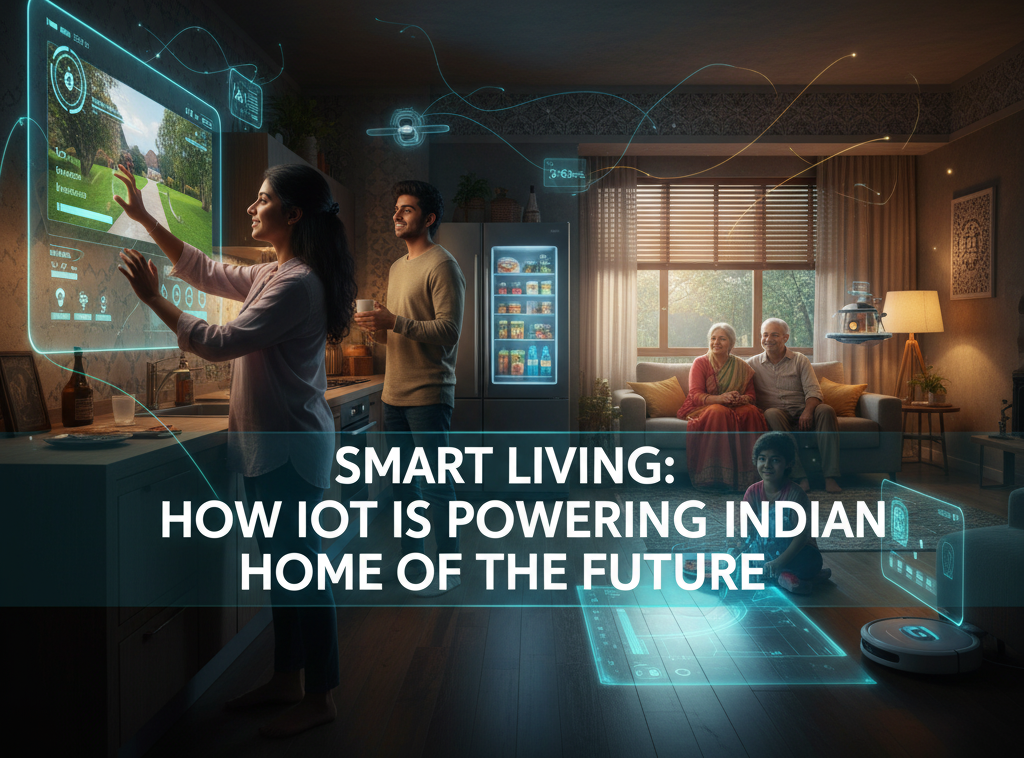Homes in India have traditionally been more than just shelters; they reflect a family’s lifestyle, values, and goals. Over the last decade, Indian houses have transformed from modest places to centres of comfort, style, and efficiency. Now, in 2025, technology has advanced this change to a new level.
The Internet of Things (IoT) is at the centre of this transformation. IoT devices, once regarded as futuristic, are now becoming commonplace in Indian homes. From bright lights to AI-enabled appliances, houses are more innovative, safer, and more sustainable than ever. This is more than simply a trend; it is a new standard that will shape the future of Indian homes.
The Rise of Smart Living in India
Efficiency is required in urban settings. With long commutes, fast-paced work, and hectic schedules, Indian families appreciate technology that saves time and simplifies daily tasks. Affordable smartphones, extensive internet connectivity, and competitive pricing of smart devices have created a favourable environment for IoT adoption.
This trend is driven primarily by younger purchasers. Tech-savvy millennials and Generation Z regard connected living as a necessity, not an option. Developers and builders realise this demand and include IoT capabilities in new projects to differentiate themselves in the market.
What was the result? Smart living is no longer limited to luxury residences in metropolitan areas; it is already reaching middle-class households and even tier-II communities.
What Makes a Home “Smart”?
A smart home employs IoT to integrate ordinary items into a cohesive system. These devices connect to the internet, allowing homeowners to remotely control, monitor, and automate tasks.
Imagine leaving for work and controlling lights, locks, and appliances from a single app. Alternatively, you can ask a voice assistant to regulate the room temperature without pressing a button. This is the essence of smart living: convenience built into regular habits.
IoT enables homes not only to respond but also to predict. Motion sensors automatically change lighting, air conditioners optimise cooling based on weather, and kitchen gadgets provide healthier food options. The home becomes an astute collaborator in lifestyle management.
Everyday Uses of IoT in Indian Homes
The power of IoT stems from its ability to blend seamlessly into everyday life. Today, Indian households are embracing a variety of applications that make living smarter:
- Intelligent Lighting Systems: Adjust the brightness automatically, save power, and create mood settings.
- Energy-efficient appliances: AI-enabled refrigerators, washing machines, and dishwashers help save on utility expenses.
- Security and surveillance: options include smart cameras, digital locks, and motion detectors that may be controlled via mobile apps.
- Smart thermostats and air conditioners allow you to control the temperature remotely, save energy, and boost comfort.
- Connected kitchens: appliances that track shopping, recommend recipes, and notify users of expiration dates.
- Health monitoring gadgets: smart wearables and connected health systems that track wellness at home.
These characteristics, which were once common in overseas markets, are now found in Indian apartments, villas, and even rental homes.
The Advantages of IoT-Powered Homes
IoT offers more than gadgets to the home. It has real benefits for them. It increases energy efficiency. Second, it improves safety and security. The connected cameras, locks, and alarms allow families to enjoy peace of mind when they are away from their home. Thirdly, convenience is improved. Automation reduces physical work. Imagine waking up with curtains that open, coffee brewing, and news on the screen without having to tap a button.
IoT also increases the value of your property. Smart homes appeal to today’s buyers and have a higher resale value. Smart living can be a lucrative improvement for investors.
The Challenges of IoT Adoption
Despite the rapid expansion of Indian homes, Indian homeowners continue to face significant challenges.
While costs are dropping, affordability remains a concern in smaller communities. Data privacy is also a concern. Customers are concerned about hacking and data security because IoT devices are heavily reliant on connectivity. When devices collect more personal data, this issue arises.
Lack of knowledge is another barrier. The Internet of Things is still not fully understood by many homeowners. The lack of information hinders adoption, particularly in areas outside metropolitan areas. Compatibility concerns also arise when devices from different manufacturers fail to connect correctly. Homeowners may find themselves with scattered systems if there is no uniformity in place.
Internet of Things and Real Estate in India
Developers are quick to recognise the impact of IoT on home purchases. New home projects now market IoT-enabled living as a fundamental feature rather than an add-on. Innovative entrance systems, integrated surveillance, and energy-efficient designs are highlighted in brochures and advertisements.
For purchasers, this offers more options and openness. For builders, IoT provides a distinct competitive advantage in saturated marketplaces. A home with linked living elements is more appealing to young purchasers searching for long-term value.
Real estate investors see IoT as a factor in property appreciation. As the demand for smart homes grows, houses with IoT readiness have better resale chances.
The Future of Smart Living in India
In the coming years, the Internet of Things will become much more integrated in Indian homes. AI-powered assistants will learn homeowners’ preferences and anticipate their needs, such as adjusting lighting before entering a room or suggesting energy-saving routines.
Government programs such as the Smart Cities Mission support this trend by promoting extensive digital infrastructure. Affordable IoT devices are also likely to reach tier II and tier III cities, growing the market even further.
Integration with renewable energy will be game-changing. Solar panels connected to IoT grids will enable homeowners to monitor and optimise their energy production and consumption.
Conclusion
In India, smart living is no longer a distant dream; it is a reality. IoT combines convenience, safety, efficiency, and sustainability in ways that traditional life cannot equal. From bright lights to connected kitchens, technology is transforming houses into not only helpful but also intelligent environments.
Yes, difficulties exist, ranging from cost to privacy. However, adoption is increasing steadily as awareness rises and prices fall. Developers, investors, and homeowners all see the advantages IoT provides.
The future Indian home will provide more than just shelter for families; it will empower them. With IoT, living becomes smarter, decisions become easier, and homes transform into dynamic participants in daily life.


Write Your Comment